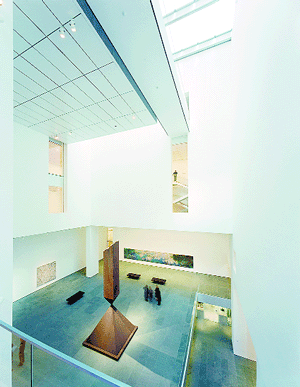Gay City News’ critics debate the re-opening of MoMA and the interpretations it suggests
Jana Sawicki in her essay, “Desexualizing Queer Politics, quotes from David Halperin’s book “Saint Foucault:” “Queer is, by definition, what ever is at odds with the normal, the legitimate, the dominate. There is nothing in particular to which it refers. It is an identity without essence.”
Queer is a political concept, intended to challenge convention.
With the reopening of the Museum of Modern Art (MoMA), five gay and lesbian working artists and art critics who write for Gay City News—Carrie Moyer, Shelia Pepe, Stephen Mueller, Andrew Robinson and Frank Holliday—followed up on a museum tour by sitting down to discuss the reinstallation of the museum’s established collection in its home, after a multi-million dollar renovation. The group put particular emphasis on the need, or indeed the possibility, for a queer interpretation.
HOLLIDAY: I love the gay rainbow flag in the lobby.
ROBINSON: That’s not a rainbow flag. That’s an Ellsworth Kelly Spectrum Painting from 1961.
HOLLIDAY: He was ahead of his time.
PEPE: Lets get to the heart of the matter. This place is not queer.
ROBINSON: No institution can ever be queer.
PEPE: Yes, I think their role is to try to accumulate a reliable history, however flawed it might be along the way. If being queer was the museum’s function then what would we do as artists? Isn’t that our job?
MOYER: It isn’t possible for a museum to be queer on a consistent basis. By the time artwork gets into the collection, the so-called transgressive moment has already passed. Anyway, the term queer is always relational.
HOLLIDAY: But my question is: If this museum was started as an alternative to the academic museums or the normal, accepted views of art of that time, then is that the same premise and definition of being queer? They continued to build an institution based on those reactive moments that continually change as these accepted norms evolve. So can we say, that since the queer moment is mercurial and cannot be institutionalized, can the Modern be a collection of queer moments throughout art history?
MOYER: Of course. I can’t think of a museum collection that can’t be read in a queer way. That’s one of the best and worst things about queer theory—it can only function as a frame. Anyway, by the time MoMA’s story gets to American painting of the 1940s and ‘50s, the narrative is so calcified around formalism that the work appears too holy.
ROBINSON: But at the time they broke with the European avant-garde and co-opted abstraction through an American vision.
MUELLER: And now it has become the canon that everything is measured against.
MOYER: I must say, I thoroughly reveled in the Church [body of work] of Barnett Newman and Mark Rothko.
ROBINSON: A perfect example of a queer moment is when you walk through the very cool, gray contemporary gallery where Richter’s black and white “Cityscape” faces the giant Twombly painting and then you gaze into the next gallery where you see the wild color of the Elizabeth Murray “Dis Pair” shaped canvas, the flashing neon of the Bruce Nauman “Human/Need/ Desire,” the Jeff Koons “New Shelton Wet/Dry Double-decker” piece and the Kiki Smith bottles with the labels of all the bodily fluids. And you look at that and you can see that something happened and art making change. This is a queer curatorial moment.
PEPE: I think you’re talking about trying to re-create something ephemeral and queer in the broadest sense—the dialogue among works that occurs in the studio and at the moment of its first reception. If you weren’t there in the mix of the moment, you never really get to experience that. Given the amount of time, or conditions in which work gets into the collection of this museum, that queer moment that made it important is long gone. All that is left is the possibility of building a canon. It will be interesting to see, what of the most contemporary acquisitions—that is, work now being acquired closer to the date of its creation – will be stored in the “basement” in ten years, in 20 years. Similarly, it would be great to see what’s in the basement now. I think the work in storage is the truly queer museum.
HOLLIDAY: There is a book with the collection from 1990 and it’s very queer. I watched the “Today Show” on the opening day and the reporter was standing in front of the Robert Gober, an out artist, and Katie Couric started making fun of the Gober piece and basically acting like she could have made it. It’s still a controversial piece for the mass media. Posing the question—Is this art? But to someone who is seeing this work for the first time, it still can be shocking.
ROBINSON: Yeah, all Katie sees when she looks at the Gober is a pair of pants with a hairy leg.
MUELLER: I love how the curators shift us into modernism through the back door from social realism right into surrealism. There’s always a crowd around Andrew Wyeth’s “Christina’s World” which is hung in a foyer on your way into the surrealist galleries with Frida Kahlo’s “Self Portrait with Cropped Hair,” Dali’s “ The Persistence of Memory, 1931,” and Oppenheim’s fur teacup “Object 1936” and Hans Bellmer’s “The Machine Gunners in a State of Grace.” It gets totally twisted and subversive.
MOYER: One of my favorite rooms was the combination of Constructivist works and Duchamp. The room presents a kind of seedbed, both formally and conceptually, for today’s art world. Ready-mades, ephemera, book art, advertising, politics are all smushed together. The paintings, Malevich primarily, are small and radical. Small gestures towards revolution. No grand painting heroics here.
MUELLER: I still thought the Kandinskys looked shocking and eccentric. He still looks like a true outsider.
MOYER: Yeah, some things still look refreshing, even shocking, like Paul Thek’s “Hippopotamus Poison,” a slab of hippo meat inside a vitrine. For me, that really felt like a queer moment by a queer artist. Very irreverent, campy and deliciously made. It has that beautiful-ugly thing going for it which reminds me of artists like Jack Smith and Tommy Lanigan-Schmidt.
HOLLIDAY: I love how they show the two different styles of Philip Guston. They have the ‘50s Abstract Expressionist painting as well as the later “Moon,” painting. That is an example of an artist having a personal queer moment. He developed the “Guston” style but in in the ‘60s he burst into his cartooned paintings that everyone hated until after he died. Everyone was freaked out because he betrayed his trademark.
MOYER: I was so glad that they left out the reams of instructional wall text that so many museums feel compelled to supply these days. It leaves the interpretation much more open.
MUELLER: The collection has a degree of simultaneity. It’s just like the Internet. It gives us access to information through many links and it just depends on the links we decide to click on. By following it to the next one we all end up some place different.
MOYER: It really depends on how we look at things. I mean I can only count one lesbian in the whole collection, Agnes Martin.
PEPE: And Julie Mehretu.
MOYER: Oh, okay two.
ROBINSON: Allegedly lesbian.
MUELLER: Or the ones that admit it!
MOYER: Or not! Speaking of big homo artists, what about the Francis Bacons? Do they always have to be under glass? That makes them look especially effete and hyperbolic.
PEPE: I really think the queer moment is when we walk in the door. I mean they set up this relatively conservative model and we can walk through and use and interpret this collection anyway that we want to.
ROBINSON: I think Sheila has an interesting point about participation. Queer is a verb, action. I always had a real problem with all the early ‘90s identity politics in art. It seems that we were requesting the benevolent acceptance into a power structure that we always rebelled against. In Naomi Klein’s book “No Logo,” she describes this whole issue and basically says that what identity politics got us was a shallow representation through advertising, but no real participation in the powers of a democracy.
MUELLER: So the corporations and institutions said, “Okay, we will put representations of you in our TV shows but you won’t be given a real say in the decisions of content or for that matter social or economic policy.”
HOLLIDAY: That’s the gaying of America. Like that big beautiful Alex Katz painting “Lawn Party” of upper middle-class gay couples at a cocktail party with tolerant straight couples. The gay issue is obsessed with being accepted and the queer issue is, “We don’t give a fuck if you accept us or not. We’re here, we’re queer and we’re not here for shopping!”
ROBINSON: It’s what we do with the information that makes it a queer moment. Like what Felix Gonzalez-Torres does in this museum. Look at the double clock “Untitled (Perfect Lovers)” in the contemporary gallery. It looks so simple and austere paying a nod to Jasper Johns and minimalist art, and yet what he is talking about in this work is his and his lover’s own mortality in the face of AIDS.
ROBINSON: I think the architecture really helps. It allows more flow between times and histories and there are no dead end spaces in the way it is laid out.
MOYER: Well, if there’s a queer mo-ment in the museum, that’s what it is.
HOLLIDAY: What do you mean?
MOYER: Well, that the so-called center to this history shifts depending on where you are in the building and the building itself emphasizes a kind of simultaneity. I can pick and choose how to read the story. I can I walk into the constructivist gallery and think about how these artists attempted to stringently meld populism, consumerism and utopia. Then I can go downstairs to look at pop art and see these same seemingly contradictory impulses reappear as a celebration of capitalism. These works are only three minutes apart and MoMA joins them together through formalism, in this case, collage.
HOLLIDAY: What I find interesting is this collection is so G-rated. There isn’t an erect penis to be found. I mean it is almost seems censored.
PEPE: I really think it pre-censored in the layers of choices of what was bought. The concerns and agenda of this museum mainly dealt with the formal concerns of art. Filling in with little pockets of pop, political or conceptual art for continuity but basically it has been a formal read of things.
ROBINSON: Yet, politically they really shuffle things up.
PEPE: They do now. When we enter the classic section of the collection on the fifth floor, we enter facing Signac’s “Opus 217: Against the Enamel of a Background Rhythmic with Beats and Angles, Tones and Tints, Portrait of Félix M. Fénéon in 1890,” where we use to enter with Cézanne. I mean this is a new way of looking at history. And in this new context we can think differently about opticality, the role of science—in a stretch it even sets us up to think about the pixel.
MOYER: All the interesting curating is done is around the architecture. For example, a work I barely paid attention to at MoMA’s Richter retrospective, the black and white “Cityscape” is placed near Gordon Matta-Clark’s split building “Bingo” and a tall window which then frames and flattens a tiny but gorgeous portion of the street outside.
HOLLIDAY: And the cut-out window revealing the staircase in the main atrium pays homage to Marcel Duchamp’s “Nude Descending the Stair Case.”
MUELLER: Even the doors with “ Danger Power Closet” and the exit signs take on a quality of art.
ROBINSON: Yeah, the architect Yoshio Taniguchi did an incredible job.
PEPE: Yes, it is interesting how all this history is pulled apart and put back together with Monet, “Reflections of Clouds on the Water Lily Pond” being the linchpin to tie them altogether.”
HOLLIDAY: They set up the use of the picture plane and the importance of the field with Monet and set up the formal concerns of the whole museum’s collection. Yet the Modern really has a tendency to cool everything down.
MOYER: I guess part of that cooled-down stance tends to play down Pop Art and focus on the abstraction. It seems like the Whitney takes a more illustrative, narrative approach and the Modern tends to focus on a formal basis. Even someone like Helio Oiticica’s “Box Bolide 12 ‘Archeologic,’” who makes sculpture out of cardboard boxes and detritus, comes off looking elegant and restrained.
PEPE: Yeah, I think different museums place their bets on different artists and over time must tell a different story based on what was available to them. Once the collection has an identity, the curators must respond to it as an entity. So with regard to MoMA, is seems fitting to look at this queer issue in terms of formal hierarchies, it’s so un-queer that painting still gets more play than anything else.
HOLLIDAY: But although there is this hierarchy for painting here, the main centerpiece in the atrium is that huge “Broken Obelisk” by Barnett Newman. Very phallic.”
PEPE: What’s interesting about the inclusion of “Broken Obelisk” by Barnett Newman is that it’s a piece of sculpture made by a painter. So it’s this queer moment in his work. And at the same time, in the context of the museum’s collection and re-installation, Newman is given the task of taking on Brancusi and the notion of the endless column, his broken column illustrating both the break and connection to Europe that is MoMA’s most normative story.
MUELLER: Yeah and it’s the centerpiece and the grandest moment in this museum.
ROBINSON: It totally overpowers the Monet, which used to be so powerful when it was in its own room and now it looks small and decorative.
MUELLER:I think the Monet looks beautiful.
MOYER: Me too.
PEPE: And the Johns “Untitled,” on the adjacent wall, provides links in different directions back through history. And it is good to see that MoMA fill old gaps. Now they are telling a story that we can better recognize.”
ROBINSON: Yes, it’s presented in a less linear way and more synchronized view of history.
MUELLER: More the way we are looking at history today, not as straight line but as interconnected and circular.
MOYER: A lot of American collections have begun to be curated like this. Asynchronous works are being dragged out of the closet.
HOLLIDAY: I really wish there was one of Keith Haring’s metal sculptures in the garden. That seems like an omission. But they do begin to address the object in the more contemporary galleries with Rachel Whiteread and Matthew Barney.
PEPE: Yes, sculpture does much better in this re-installation, but it is still very much an outdoor thing here. And indoors much of the sculpture is tipped toward painting. The big David Smith “Zig VII”—tons of color—as well as the large Donald Judd’s “Untitled.” And I find it funny that the Chamberlain’s “Essex” is a wall-mounted piece.
MUELLER: Yeah it really seems that they have a preference for painting.
HOLLIDAY: So I guess so we’re saying that a queer moment can’t exist in a museum.
PEPE: Not really. A queer moment can be experienced here but we are the performer. It’s the way we interact with the collection. I mean they don’t have to be interested in me for me to be interested in them. I don’t have to wait for their acceptance to participate in the dialogue and I can use the collection for my own needs, for my own queer moments.
MOYER: We could walk through this museum and name the artists who use gay themes in their work or who are gay or queer. But I think that idea is too limiting. Lets make the queer moment open for every one. Besides, one of the queerest artists, using Halperin’s definition, in this collection is Kiki Smith, who I believe is straight.
PEPE: The fact that they don’t totally control the interpretation is huge. And that’s an enormous opportunity.
HOLLIDAY: They’re just giving us all the clues. It’s up to us to use it.
ROBINSON: Yeah, the fact that we can participate in our own history. Now that’s a democracy.
HOLLIDAY: And that’s sooo not queer.



































